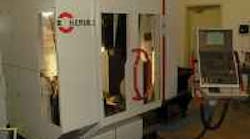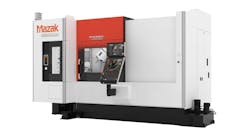It takes a high precision machine to produce the triggering mechanisms that tell explosives when to go boom.
On its Hermle C600V vertical machining center, Hanson Machine Co. produces such defense parts as this booster cup. A plastic cup loaded with the explosive CH-6 fits inside this part.
When a missle is detonated, the explosive train continues from the detonator to a detonating cord, then to the booster cup, and on to the main explosive charge.
Hanson machines these components used for loading, testing, or manufacturing explosive devices.
These machined parts belong to a cutter for explosive cable.
Off-the-shelf bombs are dumb until they get a trig-gering mechanism. These electronic devices detonate bombs at a specific, programmed time. For instance, instead of a shell exploding on impact, it can be programmed to penetrate multiple layers of a bunker wall before going off.
Wayne Hanson's company, Hanson Machine Co. in Spooner, Wis., makes these programmable triggers, and he has personally witnessed tests where a smart bomb shot through three 4-ft-thick layers of concrete before blowing up on the other side. Even though these triggers are electronic, there is still a great deal of machining involved, and the shop does most of it on a Hermle C600V vertical machining center.
Obviously, when dealing with such important components, accuracy is paramount. Fortunately, the bases of the Hermle C-Series line are mineral cast for increased thermal and vibra-tory stability. This casting has the same look and feel as the granite used for inspection tables. High walls on the mineral casting base support the upper carriage, making the C600V a gantry design. As a modified gantry design, there is a third linear guide rail placed directly under the Y-axis ballscrew. This creates a triangular guide system where the rails support each other.
A 40-mm ballscrew placed directly over the third rail creates a smooth guiding action and reduces sticking or twisting motions. On top of each gantry support, are oversized linear guideways. All guideways and drives are outside of the machine's work area. With linear accuracies of 0.00008 in., the machine is adaptable to the future tolerances of the explosives industry, says Hanson.
With the C600V's gantry design, all three axes of motion are in the carriage on top of the three guide rails, which offers three major advantages. The first is that the table and workpiece remain stationary, which keeps the machine dynamics and axis drive constant. Secondly, since there is no heavy part load on the axis drives, the carriage feeds faster for high speed machining and contouring. Lastly, from a programming aspect, operators simply position cutting tools to move around a stationary workpiece.
In Hanson's shop, parts change constantly. That's why it is geared for small production runs, typically up around 2,000 or 3,000 pieces. But Hanson believes the shop could easily handle a 10,000-piece job. In addition, the trig-ger components are high-end, close-toleranced, and difficult-to-machine — difficult because of the part designs. For this reason, Hanson recently added a fourth-axis option to the C600V for rotary contouring and indexing.
Hanson particularly likes the C600V's toolholding/changing system. There is no additional articulation in order to change tools because the system is basically part of the spindle. Tools are totally isolated from the machining area, adds Hanson, keeping chips and coolant spray off the tapers of the stored tools. In fact, tools are exposed only during a toolchange. And because there is no wear and tear on the spindle from clamping chips in with the toolholder, tooling seats properly to eliminate out-of-balance problems.
The 30-tool automatic changer has no mechanical tool arm and, therefore, fewer parts that could fail. Index time from tool #1 to #15 is 1 sec, and chip-to-chip change time is 5 sec.
Hanson produces slightly less than #4 finishes directly off the Hermle, so some parts require no polishing afterwards. Tolerances are held to within 0.0001 in., and, adds Hanson, the C600V's high-speed spindle easily machines the harder steels the company uses — 4130, 4340, and other materials with Rc hardnesses between 45 and 50, for instance. For these parts, operators make small cuts at high spindle speeds, usually around 10,000 rpm.
The machine's infinitely variable to 12,000 rpm spindle drive has a hollow-shaft, water-cooled AC motor. It accelerates from 0 to 12,000 rpm in 1.5 sec. and includes a collision protection device.
Most of the shop's parts are fairly small with cross sections no more than 3 or 4 in., so feedrate isn't critical. But the machine has excellent acceleration and deceleration, adds Hanson. Positioning times are short with the machine's acceleration of 16.4 ft/sec 2 and a programmable feedrate of 1,378 ipm. Digital speed control lets the C600V quickly respond when the CNC communicates to the axis drives, providing more accurate contouring.
Explosive supportHanson Machine Co. is about a year old. It supports a separate, larger company by producing tooling, fixturing, and specialized piece parts. The larger company is Stresau Laboratory Inc., also owned by Wayne Hanson. The lab does contract development, research, manufacturing, and testing of explosives for defense and other industries. Previously, the company would outsource most of its production machining. Now, with the machine shop, approximately one-third of it is kept in-house. After being machined at the shop, the small, internal explosive parts move to the lab for loading into such things as Patriot missiles, ammunition for Apache helicopters, or 120-mm tank rounds. The lab portion has been in business since 1961, and Hanson purchased it in 1995. There are 50 employees in the lab, while a staff of three runs the shop. Stresau Lab is known as a fuse explosive train specialist, reports Hanson. This reputation is a result of 35 years of explosive train safety and reliability evaluation. Developed by the lab in the 1960s, these evaluation protocols are still considered international standards today. Stresau's approach involves less test shots to demonstrate reliability. Fewer shots means customers have lower evaluation costs. The lab evaluates the safety and reliability of many U.S. Army fuses and a large quantity for the Air Force and Navy. |






